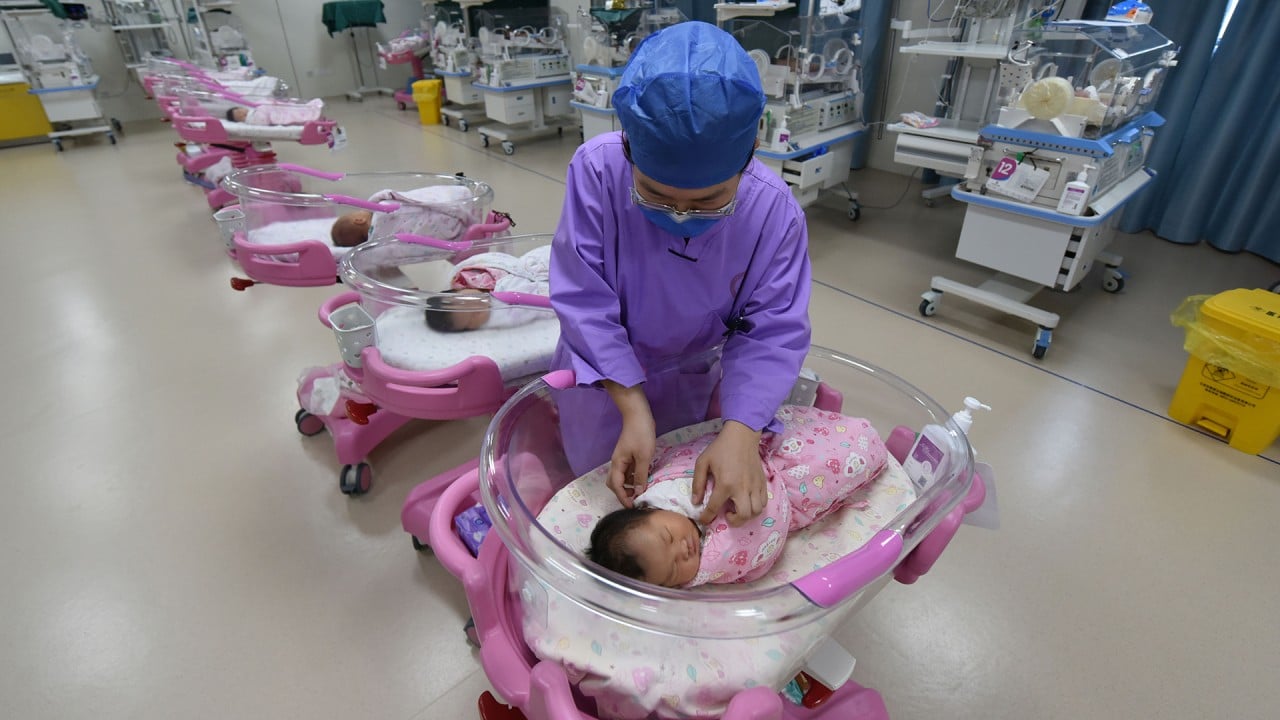
03:23
China posts record-low birth rate despite government push for babies
China’s population falls by 2.08 million to 1.4097 billion in 2023 as births tumble, adding to demographic concerns
- China’s overall population fell by 2.08 million last year, while births declined by 5.6 per cent to 9.02 million
- The world’s second-largest economy is under pressure as its population declines and gets older
China has reported a population drop for the second consecutive year in 2023 and a record low birth rate, raising concerns over the long-term growth prospects of the world’s second-largest economy.
Slightly over 9 million babies were born in 2023 – the lowest level since records began in 1949 – while about 11 million people died, pushing the death rate to a five-decade high.
“Replacing humans with robots is showing its economic benefits amid a labour shortage and rising labour costs,” it said.
Like if the US lost New Mexico: 6 takeaways from China’s 2023 population data
China installed half the world’s industrial robots in 2022, according to data from the NBS and the International Federation of Robotics (IFR).
In 2022, it ranked fifth globally after South Korea, Singapore, Germany and Japan for robot density in the manufacturing sector, following a doubling down on efforts to boost industrial automation from Beijing.
“China made its way to fifth place in 2021 and maintained this position in 2022. The country´s massive investment in automation [has yielded] a high robot density of 392 robots per 10,000 employees – despite a huge workforce of roughly 38 million people in the manufacturing industry,” the IFR said in a report on January 10.
For comparison, South Korea has a robot density of 1,012 per 10,000 employees - a world-topping figure the IFR attributes to “two large customers”, the country’s “strong electronics industry” and “distinct automotive industry”. It, too, is classified as an ageing society, with a fertility rate even lower than China’s.
A declining birth rate means a continuously shrinking workforce, which “will inevitably bring about slower economic growth”, said Lin Caiyi, vice-president of the China Chief Economist Forum Research Institute.
Reward grandparents, ban antinatalist content to boost China’s tumbling births
“The pressure on social insurance expenses is also increasing year by year as the population ages,” she said.
The falling number of new babies resulted in the lowest birth rate in over seven decades, with 6.39 births for every 1,000 people compared with 6.77 in 2022.
Meanwhile, 11.1 million people died in 2023, up by 690,000 from 2022, pushing the national death rate to 7.87 per 1,000 people.
Authorities have not disclosed the number of coronavirus-related deaths after China dropped its stringent health control measures at the end of 2022, but the death rate last year was an uptick from 7.37 per thousand the year before – and the highest since 1969.
China’s official population data includes its 31 provinces, autonomous regions and municipalities, as well as servicemen, but excludes foreigners.
While an ageing population and slower labour force growth is a trend affecting multiple major economies, China is experiencing a unique demographic transition thanks to previous policies and rapid growth in robot application.
The one-child policy – a measure implemented from 1980 to 2015 that discouraged most families from having more than one child – has made China’s births plummet at a faster pace than other parts of the world, according to a report released by the Development Research Centre of the State Council late last month.
It took just 20 years for China’s total fertility rate to drop from 5.5 to 2.1, compared with 30 years on average for East Asian countries. A fertility rate of 2.1 – the average number expected to be born to one woman over one lifetime – is known as the replacement rate and is generally seen as the “magic number” to ensure a stable population.
By further comparison, it took the world 58 years to see the average fertility rate fall from 5 to the current 2.3, the report said.
China’s overall population is set to see steeper decline in the coming years, said professor Peng Xizhe from the Centre for Population and Development Policy Studies at Fudan University.
It’s almost certain that the population will go on with negative growth
As the cloud of the coronavirus pandemic wanes, and pronatalist policies “more or less make some difference”, the number of newborns per year might rebound a little but is unlikely to exceed 10 million, he said.
“A rise in deaths related to Covid-19 may have occurred in early 2023 … Looking ahead, as the population ages, annual deaths will continue growing in the future, surpassing 10 million people each year,” Peng said.
“Therefore, with deaths outnumbering births, it’s almost certain that the population will go on with negative growth.”
China’s population growth had been slowing since 2016 as the high cost of raising children, a greater pursuit of individualism and a diversified lifestyle dampen enthusiasm to start a family. The country’s zero-Covid policies, implemented between 2020 and late 2022, are also perceived to have contributed to the slide.
Beijing has rolled out a series of measures in recent years in an attempt to reverse the ageing trend and boost births, but they have failed to yield results.
The three-child policy was followed by a mixture of incentives from local governments, ranging from prolonged parental leave to tax cuts and cash rewards for families with more than one child.
Despite these efforts, China needs to build a more integrated policy system to foster a supportive environment for childbearing, said Yuan Xin, a professor of demography at Nankai University’s School of Economics.
“Such a system should focus on equality and needs to be consistent across the country,” he said.
“There should not be big differences in the treatment of different people because of their birth order, race, the province they live, and whether they’re from urban or rural areas.”
Concerns over equality have risen in the past few years as some local governments rolled out measures to stimulate births based on controversial criteria.
We need to improve policies on maternity insurance and family tax … guaranteeing basic living standards and benefiting people’s livelihood
In Weifang, Shandong province, a policy issued in March last year stated that families do not have to pay tuition fees for their third child attending high school, but the offer did apply to the first two children.
Lu Jiehua, deputy director of the Centre for Healthy Ageing and Family Studies at Peking University, said authorities should also do more to provide follow-up support instead of only offering a one-off subsidy after a child is born.
“We need to improve policies on maternity insurance and family tax, so the government will play a better role in guaranteeing basic living standards and benefiting people’s livelihood,” he said in a research paper published by the Population and Health journal in October.
Peng, the Fudan University professor, added that the key to motivating people to have children is an improvement in gender equality, which is a basic national policy contained within China’s constitution, but one that is still poorly implemented and not properly supervised.
“In reality, it is still hard to find more paternal engagement in parenting and a better balance of family and work for women,” he said.
“Unlike the stock market, which may be immediately stimulated by a policy, it takes a much longer time for measures to work when it comes to making people willing and able to reproduce.”




